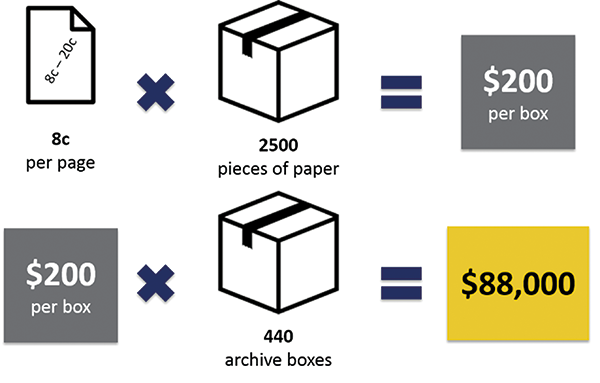Is digitising your physical records worth the financial investment?
The short answer is: no. Before I explain why, let me take you through a real world (and very common) scenario that I recently encountered.
Public and private organisations accumulate paper-based records during the course of their business. When left unmanaged, these records build up and up until the cost to maintain and store becomes unreasonable. While some organisations are finding success moving into the digital world through the use of electronic document and records management systems (eDRMS) and recordkeeping compliant information systems, there are still organisations that struggle with the sheer amount of work required to manage and maintain physical records.
We see this in many organisations: a tendency to keep records and never dispose of them. Most often this is simply due to a lack of awareness of how long to keep records, and the lack of a retention and disposal schedule to inform when a record can be legally destroyed.
I recently worked with a client who wanted to do away with their legacy physical records by digitising what they could and disposing of the rest. The problem was that they had little understanding of what records they were storing and if any could be legally destroyed.
Following our SHRINK methodology, we appraised 800 boxes of records using a retention and disposal schedule and we were able to identify 360 boxes (45%) that could be disposed of immediately. The remaining 440 boxes were to be digitised and captured within an eDRMS which was going to require an initial investment of more than $A88,000. This is displayed in the infographic below:

For the moment, forget about the intrinsic benefits associated with having digital records
- The standard archive box can hold on average up to 2500 – 3000 pieces of paper (i.e. preservation and accessibility) and think about the cost of digitising.
- The average cost to scan an A4 page is between 8c – 20c per image (one side of the page).
Let’s assume we don’t include some of the additional costs associated with digitising e.g. setup fees, data entry and indexing fees, optical character recognition, scanning resolution and storage options (these costs contribute to a higher per image cost) and we pay the minimum 8c per image.
If we have 2500 pieces of paper (single sided, loose and no staples – yes that costs more too) then we are looking at roughly $A200 per archive box.
That means that the organisation’s 440 archive boxes would require an initial investment $A88,000 to be digitised.
Compared to the current cost to store the physical records of around $A400 per month (or $A4,800 per annum) this means that it would take 19 years to recoup the cost of digitisation assuming no more physical records are stored. See below:

The majority of retention periods applied to the records being digitised is 7 – 12 years, so would it even be worth the investment given that these records would be deleted long before the 19 years are up?
So, why digitise?
While digistisation requires a large investment, records that are required to be retained for a short period of time (between 7 and 30 years) provide little to no return on investment.
However, organisations can expect to receive a return on investment for digitised records that are required to be retained for long periods of time, roughly 30 years or more.
A cost-benefit analysis should be performed before undertaking all digitisation projects to look at whether digitising long term records is worth the investment against how often the records are accessed. If records are only required to be retained for compliance or ‘in case something happens’ then there may be a case to retain these records physically because it will be more cost effective. On the other hand, permanent and vital records may require frequent access and preservation, and this is where digitising has its benefits.
Digitising just to reduce physical storage costs does not stack up
Mark Salmon is a consultant with Glentworth. Email him at mark.salmon@glentworth.com
